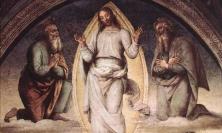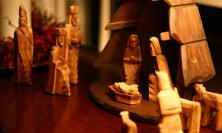During the Year of Faith, Thinking Faith will be exploring the nature of faith by looking at how Christians and others use and understand the word. Scripture scholar Peter Edmonds SJ begins with the gospels, analysing the references to ‘faith’ in Matthew, Mark and Luke. How can we build a rich vision for a life of faith by looking at the different ways in which the evangelists use the word?
An obvious question to ask in this Year of Faith is, ‘How is the word ‘faith’ used in the New Testament?’ The Greek word for ‘faith’ is pistis and it occurs in 24 of the 27 books that make up the New Testament. In this short article, we confine ourselves to the gospels of Mark, Matthew and Luke; surprisingly the word is never used in the gospel of John. With two exceptions, we will ignore occurrences of the related verb, ‘I believe’ (pisteuo) which by contrast is found 98 times in John’s gospel.
The Gospel of Mark: Believe in the Gospel
We begin with our first exception, because the first words spoken by Jesus in Mark include the word ‘believe’. He writes, ‘Jesus came to Galilee, proclaiming the good news of God and saying, “The time is fulfilled and the kingdom of God is at hand; repent and believe (pisteuo) in the gospel”’ (Mark 1:14-15). Who, we ask, responded to this appeal by displaying the faith (pistis) that Jesus demanded? Those who know Mark’s gospel, call it the ‘gospel of paradox’. The paradox here is that it is not the disciples who Jesus called by the lake (1:16-20) or on the mountain (3:13-19) who give an example of faith, but people who appear only once in Mark’s gospel and are not heard of again. Their response can speak to us in this Year of Faith.
The word ‘faith’ (pistis) occurs five times in Mark. It is applied first to the four men who brought a paralysed man to Jesus by lowering him through the roof of the house where he was. Because of their faith, Jesus forgave the sins of this man (2:5). This first use of the word reminds us that faith shows itself in action. Paul made this point when he wrote to the Galatians of, ‘faith working itself out in love’ (Galatians 5:6). And we may note that where Jesus found faith, there he announced that sins were forgiven.
The second use of this word is addressed to the disciples of Jesus. In a boat on the lake of Galilee, they ran into a storm and panicked because they thought they were about to sink. Jesus calmed the storm and said to his disciples, ‘Have you still no faith?’ (4:40). Although previously they had witnessed the power of Jesus in healing and controversy, and heard his authority in teaching, in crisis they despaired. Here, as elsewhere in Mark’s gospel, the behaviour of the disciples of Jesus offers us a warning rather than an example. Solid faith, such as the disciples were yet to acquire, enables the believer to cope with the storms we meet with in our human experience.
The third occurrence of this word ‘faith’ in Mark is addressed by Jesus to a woman whom he has just cured. Her sickness had already lasted for twelve years. Her cure came in two stages. First she sought a cure by touching Jesus, but this led only to ‘fear and trembling’. It was only after falling down before Jesus and telling him ‘the whole truth’, that she found her cure complete and Jesus said to her, ‘Daughter, your faith has saved you’(5:34). From her we learn how faith can grow; it implies a personal and confident relationship with the Lord.
The word ‘faith’ occurs a fourth time in Mark in his account of the cure of Bartimaeus. He was a blind beggar who heard that Jesus was passing by. Three times he pleaded with Jesus for mercy and for the restoration of his sight. His prayer was granted and Jesus said to him, as to the woman previously, ‘Go, your faith has saved you’ (10:52). Paradoxically, Bartimaeus ignored this instruction to go; instead he followed Jesus on the way that led to Jerusalem, the city where Jesus was to die. His faith had expressed itself in repeated and persevering prayer, despite discouragement from those standing by. His example teaches us to persevere in prayer to the person of Jesus. Faith encourages the habit of regular and persistent prayer. Greek Christian tradition in particular has valued this prayer of Bartimaeus, ‘Jesus, Son of David, have mercy on me’ (10:47); monks of old repeated it, as they trudged off to their work in the fields.
Finally, Jesus spoke this word ‘faith’ to his disciples when they discovered that the fig tree that he had cursed the previous day had withered. He told them to ‘have faith in God’ (11:22), and then gave them a lesson on the power of prayer. Here is Jesus’s longest instruction of prayer in this gospel since there is no ‘Lord’s prayer’ in Mark. It consists of three sayings, two of which appeal more to prophetic exaggeration than to day-to-day reality. We do not really expect our prayer to move mountains or our every prayer to be answered, but prayer is to be from the heart, is to be confident and trusting, and is to include mutual forgiveness. As in the Bartimaeus story, we recognise the link between prayer and faith.
But perhaps the most memorable paradoxical saying about faith in Mark’s gospel is spoken by another of its minor characters. The word used here is not faith (pistis) but its opposite (apistia). The father of the epileptic boy, whom the disciples of Jesus were unable to cure, cried out to Jesus and said, ‘I believe. Help my unbelief’ (9:24). This prayer is included in one of the recommended prayers for this Year of Faith:
Lord,
Let me see your face,
Know your heart
and experience your love in my life.
Strengthen in me
the precious gift of faith.
I believe Lord;
Help my unbelief.
Amen.[1]
The Gospel of Matthew: You of Little Faith
Matthew’s gospel is reckoned to be a revision of Mark’s, so it is now time to examine how he treats Mark’s references to ‘faith’. Jesus’s first public words in Matthew do not include the word ‘believe’. He simply asks for repentance (Matthew 4:17). His first use of the word ‘faith’ comes in his narrative of the cure of the centurion’s servant, an incident not reported by Mark. There Jesus announces that, ‘not even in Israel have I found such faith’ (8:10). Jesus is here dealing with a Gentile and this reminds us how, from the beginning, faith found a home in such outsiders. At the beginning of the gospel, Gentile Magi were the first to worship the child Jesus (2:11) and at its conclusion, another centurion ‘and those with him’ confessed Jesus as Son of God (27:54). Such texts encourage us to look for signs of faith outside our own group.
Like Mark, Matthew uses the word ‘faith’ in connection with the men who brought the paralytic to Jesus (9:2) and in a shorter version of her cure, Jesus told the woman who had been sick for twelve years, ‘Your faith has saved you’ (9:22). When Jesus cured two blind men, in a passage that resembles the cure of Bartimaeus in Mark, he said, ‘According to your faith, be it done to you’ (9:29). Both in this narrative and in that of the cure of the Canaanite woman, to whom he said, ‘Woman, great is your faith’ (15:28), Matthew links the readiness of Jesus to heal with the faith demonstrated by those in need.
What is special in Matthew is an expression used four times in this gospel, once in Luke and never in Mark. The Greek word is oligopistos, best translated as ‘person of little faith’. In Matthew’s account of the storm on the lake, Jesus says to his disciples, ‘Why are you afraid, you of little faith?’ (8:26) He addressed them again in these terms when they confused his words about the yeast of the Pharisees and Sadducees with ordinary bread: ‘You of little faith, why are talking about having no bread?’ (16:8) In Matthew’s account of the cure of the epileptic boy, Jesus makes no mention of the faith of the father as in Mark; rather he tells his disciples that it was because of their ‘little faith’ that they were unable to cure the boy (17:20). He had already addressed them in these terms in the Sermon on the Mount, ‘Will he not much more clothe you – you of little faith’? (6:30) Finally, Jesus told Peter that it was because of his ‘little faith’ that he began to sink in his attempt to walk on the water (14:31).
Commentators on Matthew suggest that the disciples in this gospel represent the members of Matthew’s Church. In this Year of Faith, Matthew challenges the Church of today to acknowledge its ‘little faith’, as he did his disciples when they failed to cure the epileptic boy. ‘If you have faith as a grain of mustard seed, you will say to this mountain, “Move from here to there and nothing will be impossible for you”’ (17:20). A similar saying about faith moving mountains is included in Matthew’s account of the withered fig-tree which he reproduces from Mark (21:21). Again faith and prayer go together.
The Gospel of Luke: Increase Our Faith
At first sight, Luke adds little to what we have noted in Mark and Matthew. Once more the word faith is used in connection with those who brought the paralytic to Jesus (Luke 5:20) and with the centurion whose servant was healed (7:9). Four times in Luke, in contrast to the two occasions in Mark and Matthew, we find the expression, ‘Your faith has saved you’. Jesus addresses it not only to the woman cured of her haemorrhages (8:48) and to the blind man whom Mark calls Bartimaeus (18:42), but also to the woman ‘in the city who was a sinner’ (7:37, 50) and to the leper who returned to praise God (17:19). Such salvation is a theme in Luke, as John the Baptist proclaimed in his preaching, ‘All flesh shall see the salvation of God’ (3:6). Only in Luke is Jesus called saviour, as the angels announced to the shepherds (2:11).
While Matthew challenged his community because of its ‘little faith’, generally Luke is kinder to the disciples of Jesus than his predecessors. In describing the storm on the lake, Jesus asked his disciples, ‘Where is your faith?’ (Luke 8:25), in contrast to the ‘no faith’ of Mark and the ‘little faith’ of Matthew. As they approached Jerusalem, the disciples asked him, ‘Increase our faith’ (17:5), as previously they had asked him to teach them how to pray (11:1). He told them a parable about a widow who pleaded with an unjust judge. His conclusion was a lament, ‘When the Son of Man comes, will he find faith on earth? ’ (18:8) At the last supper, Jesus prayed for Peter ‘that your own faith may not fail’ (22:32). Once more we note the link between faith and prayer.
The Johannine Writings: Conquer the World
While the gospel of John does not include the noun ‘faith’, it does contain nearly a hundred instances of the verb, ‘I believe’ (pisteuo). We include here our second example of the use of this verb, namely the beatitude which Jesus addressed to Thomas who had doubted, and to all who hear this gospel, ‘Blessed are those who have not seen and yet have come to believe’ (John 20:29). The noun ‘faith’, however, does occur once in the letters of John: ‘And this is the victory that conquers the world, our faith. Who is it who conquers the world but the one who believes that Jesus is the Son of God?’ (1 John 5:4-5). Here indeed is encouragement for this Year of Faith! May our faith conquer the world!
Growing in faith
We learn from the gospels of Matthew, Mark and Luke that as we grow in our knowledge of the goodness and love of God, so will we grow in our faith. This ought to be our hope during this Year of Faith. The last time that Matthew uses the word pistis (faith) occurs is to record Jesus’s words to the scribes and the Pharisees, the bluntest of his addresses to them in all the gospels: ‘For you tithe mint, dill and cummin, and have neglected the weightier matters of the law: justice and mercy and faith’ (23:23). May Jesus not have to make the same lament over us.
Peter Edmonds SJ is a member of the Jesuit community at Stamford Hill, North London.
[1] Roman Catholic Diocese of Westminster, 2012
More articles for the Year of Faith:
![]() ‘Thinking Faith’ by Damian Howard SJ
‘Thinking Faith’ by Damian Howard SJ
![]() ‘A Contemplative Space:
‘A Contemplative Space:
Pondering God’s mystery across faiths ’ by Michael Barnes SJ
![]() ‘Faith in the Old Testament’ by Nicholas King SJ
‘Faith in the Old Testament’ by Nicholas King SJ
![]() ‘Faithful imagination’ by Rob Marsh SJ
‘Faithful imagination’ by Rob Marsh SJ
More articles by Peter Edmonds SJ on Thinking Faith:
![]() ‘Saint Mark the Pastor’
‘Saint Mark the Pastor’![]() ‘Matthew: A Saint for Today’
‘Matthew: A Saint for Today’![]() ‘How to Read the Gospel of Luke’
‘How to Read the Gospel of Luke’






